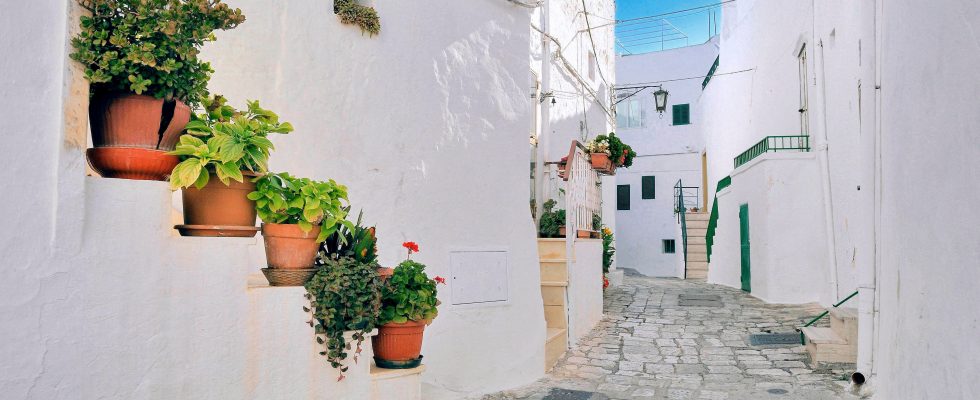“I don’t want to transform Paris into Mykonos, but maybe we need to move the lines a little so that it’s a little less the furnace. The albedo, like the place of plants or water in the city, is the one of the essential subjects, in an attempt to reduce the heat wave risk.” Raphaël Ménard is an architect and engineer, president of the national architecture agency AREPand he defends a clear idea : paint in white, and lose degrees.
In the Cyclades, in Greece, houses, alleys and sidewalks are covered with immaculate whitewash. White is indeed an ally against the sun thanks to the albedo phenomenon, namely the ability of a surface to reflect solar energy, depending on the colors. The lighter a surface, the higher its albedo, and the more heat it reflects. For example, fresh snow reflects 75 to 90% of solar energy, its albedo is between 0.75 and 0.90 (a high number, since the order of magnitude of the albedo cannot exceed 1.) Black objects , which have a low albedo, warm up more quickly. A problem that arises particularly in urban spaces, whose albedo is on average around 0.15, which easily makes them heat islands.
Albedo is, for Raphaël Ménard, part of a concrete and achievable (since inexpensive) acclimatization approach at any scale, from car roofs to municipal establishments or roads. Painting the car roof white, for example, would partially reflect the solar energy, thus preventing the vehicle from heating up too quickly, and therefore over-consumption of the air conditioning. The albedo could therefore even in this type of case, attenuate greenhouse gas emissions on a small scale.
Similarly, repainting roofs in a light color could have a significant effect on the temperature of cities in general, roofs representing 30 to 50% of urban spaces “captured” by the sun. The installation of these “cool roofs”, in other words reflective surfaces, compared to asphalt roofs, could bring about a significant change. Thus a simple correction of the roof albedo by +0.3 could reduce the solar heat absorbed by the city by 10%.
While according toInternational Energy Agencya tripling of the use of air conditioning in Europe is expected by 2050, any solution allowing a slight drop in temperature could lead to an attenuation of this consumption, in particular in Urban Heat Islands (ICU), such as La Défense For example.
In Melbourne or Milan, the application of this phenomenon was able to reduce the temperature by up to 6 degrees felt. In France, environmental regulations for new construction do not prescribe a reference value for albedo, which Raphaël Ménard regrets.
A new half-hearted political project
Although it has already been tested in several world cities such as New York or Sydney, the albedo phenomenon, as a lever to stem the impact of global warming, remains little known and little democratized. “The democratic collective ignorance on the subject must be weakened, encourages Raphaël Ménard. People must be more aware of the various subjects on ecology.” The specialist above all defends the economic dimension of this approach: “It costs nothing, the pot of white paint is the same price as the pot of black paint. It’s almost cheaper in the case of cars!”
Referred to in the sixth report of the IPCC (Intergovernmental Panel on Climate Change) last February, albedo also began to be discussed in public policy. Recently, the Europe Ecologie Les Verts group took up the subject to bring it to the National Assembly in December 2022 as part of the bill on the acceleration of the production of renewable energies. Without success so far.
Despite everything, the green deputy Julien Bayou does not despair of imposing it again in the public debate, as he explains to The Express : “I wore it to the Assembly, I will continue to wear it, I will come back to the charge in the fall. At a lower cost, we can improve living conditions in summer, in nursing homes or schools. It does not cost cheap, it’s a lot of work for our craftsmen… There’s no reason to oppose it.” The MP also encourages initiatives that take the albedo into account on a voluntary basis, to better cope with heat waves in the years to come.
White accessible at all scales
Still, if the phenomenon of albedo has already been practiced for a long time in the Mediterranean countries, completely repainting the French territory in white seems impossible, in view in particular of the architectural diversities. Faced with skeptics, Raphaël Ménard defends a master plan for the clarification of structures and progressive, stepped transport. He suggests combining this scheme with other urban adaptation policies such as the greening of urban spaces: “As soon as we can measure the effect, we might as well go for it, and even if it doesn’t completely change the situation , small streams make big rivers!”
